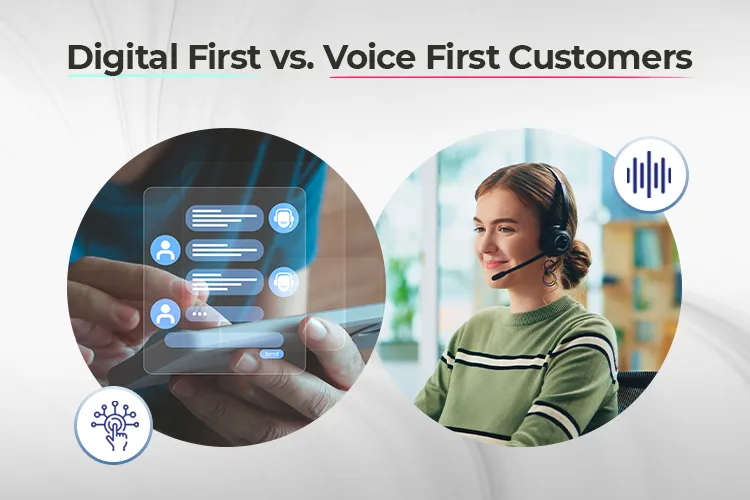“Digital-first” looks great on a slide deck. Faster support, fewer agents, lower costs. But when you zoom in on the customer experience, it’s not always that simple. Plenty of people still want—sometimes need—a real person on the other end of the line. If your support strategy forces everyone through the same digital tunnel, you’re not streamlining the experience. You’re blocking it.
- Digital-First Isn’t Digital-Only: Automation can’t replace human support—customers still want real conversations when it matters most.
- Voice Support Remains Critical: Elderly customers, non-native speakers, and emotionally stressed individuals rely on phone access for clarity and comfort.
- Flexibility Over Force: Forcing users into chatbots or self-service paths without escape routes leads to frustration and lost trust.
- Data-Driven Channel Strategy: Monitoring drop-offs, escalations, and feedback helps identify when customers need human interaction.
- Unified Solutions Enable Balance: Platforms like NobelBiz Omni+ integrate digital and voice channels, giving customers choice without sacrificing efficiency.
💡What Does “Digital First” Actually Mean?
For some companies, it means automating everything. For some customers, it means feeling
locked out.
How Companies Define It
Most companies translate “digital-first” into: reduce calls, automate everything, push self-service. On paper, it looks like efficiency. In reality, it often means replacing human interaction with bots, long knowledge bases, and layered menus that frustrate more than they help.
There’s value in automation—but only when it fits the need. Offering chatbots for quick balance checks or order statuses makes sense. But applying the same digital flow to every customer issue ignores one important fact: not all problems can—or should—be solved without a human.
Support teams, on the other hand, are trained to fix problems. They see the messy reality: technical limitations, onboarding hiccups, miscommunications.
When these two teams don’t share information, strategies, or even basic customer insights, the result is a widening gap the customer falls right into.
“Digital-first doesn’t mean digital-only. The moment you make it hard to speak to a human, you’re adding friction to what should be a simple experience.”– Christian Montes, Chief Operating Officer at NobelBiz
⚠️How Customers Experience It
From the customer’s side, digital-first can feel like getting ghosted. They click through menus, explain themselves in a chat, get redirected, re-explain, and still end up with no answer. It’s not just annoying—it’s exhausting.
The customer isn’t thinking about your tech stack. They’re thinking, “Why can’t I just talk to someone?”
🔥Where Things Start to Break
When the issue is urgent, emotionally charged, or just plain complicated, automation falls apart. People facing billing issues, sensitive account problems, or technical glitches don’t want to type their life story into a chatbot. They want someone who listens, understands, and helps.
Salman Aslam
Director Support – Quality & Training at WORK Inc.
‘The support team at Nobelbiz understood our business requirements and we we’re able to push through seamlessly’
🌪Who Gets Left Behind in Digital-Only Support?
Elderly Customers
A lot of older adults simply aren’t fluent in digital channels. They may not trust them. They may not even know they’re stuck in one. For them, voice support isn’t a luxury—it’s the only real option. Ignoring this group means leaving behind a loyal and often long-standing customer base.
Non-Native Speakers
Text-based support assumes a certain comfort level with reading, typing, and understanding a specific language. But if English isn’t your customer’s first language, voice conversations—especially when spoken slowly and clearly—can feel far more accessible and less intimidating than reading through complex instructions or interpreting chatbot answers.
Emotionally Stressed or Urgent Situations
There are moments when the human element matters most. Maybe a customer’s travel plans fell through, their payment failed, or their service was interrupted unexpectedly. In those situations, they don’t want to troubleshoot through a flowchart. They want to hear a calm, competent voice on the other end, offering real help—not another “Did that solve your problem?”
Related Article
Brayan Carpio
Senior Call Center Manager, Call4You Marketing
🏗 Balancing Digital Tools with Human Access
It’s not either-or. It’s about giving people options.
🗣Design for Flexibility, Not Force
The key isn’t to choose between digital and human—it’s to offer both, and let the customer pick. Design your support system like a well-lit hallway with clear doors, not a maze. Don’t force people to dig through pages just to find your contact number. If a customer wants to speak to someone, make that path obvious and easy.
NobelBiz Omni+ helps teams offer multichannel support that still feels unified. You can integrate self-service where it makes sense, without locking the door on human help.
📢Let People Opt into Voice When Needed
Some problems require a real conversation. Instead of burying the phone number or limiting voice access, offer clear “exit points” in your digital flows—like a “Need to talk to someone?” button at the right moment. This kind of thoughtful routing gives customers a way out when automation isn’t working.
With NobelBiz Voice Carrier, you get reliable, high-quality voice infrastructure that doesn’t drop calls or distort communication—exactly what’s needed when emotions are high and clarity matters.
“We’ve seen time and time again: customers will tolerate a chatbot—until their issue is personal, urgent, or confusing. That’s when voice becomes non-negotiable.”- Mike Mcguire, Chief Revenue Officer at NobleBiz
Use Data to Guide Channel Strategy
Don’t assume you know what your customers want—look at the data. Where are people abandoning chats? Where do escalations spike? What feedback are your agents hearing? Use those signals to refine your approach.
If you’re seeing an increase in customers asking for callbacks or leaving negative feedback in digital channels, it’s a sign that voice still matters. Let the numbers—not assumptions—shape your support strategy.
Digital-first is a smart strategy—until it becomes human-last. When customers have real problems, they want real people. It’s not about choosing between bots and humans. It’s about understanding when each one matters—and designing your support system to reflect that.
If you’re serious about delivering flexible, human-centered service, consider platforms like NobelBiz Omni+ and NobelBiz Cloud Contact Center. They help you keep the efficiency of automation without losing the empathy and trust that only real conversations can offer.
FAQs About Digital-First vs. Voice-First Support
Discover how NobelBiz helps call centers maximize customer engagement, boost answer rates, and ensure compliance with industry-leading solutions.

Andrei is an experienced marketing professional specializing in propelling growth for both B2B and B2C companies. Proficient in streamlining marketing operations and enhancing lead and customer experiences through SEO and marketing techniques.








